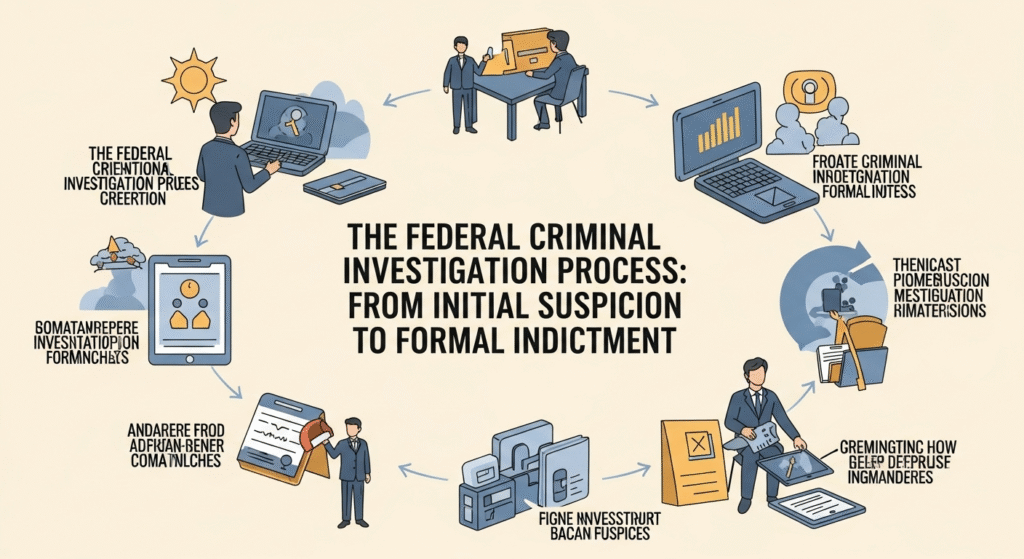The Federal Criminal Investigation Process
From Initial Suspicion to Formal Indictment: A Visual Guide
A Meticulous and Often Lengthy Journey
Federal criminal investigations are comprehensive, multi-stage inquiries into violations of federal law. This process is not a quick sprint but a marathon, often lasting months or even years. It begins with a whisper of suspicion and culminates in a formal indictment, involving a host of specialized agencies, sophisticated evidence gathering, and critical legal reviews. Understanding this path is key to grasping the gravity and complexity of the federal justice system.
How Investigations Begin
Public & Informant Tips
Reports from citizens, victims, or confidential informants often serve as the initial spark for an investigation.
Suspicious Activity Reports
Financial institutions are required to report unusual transactions, flagging potential money laundering or fraud.
Agency Referrals
Cases are often passed to federal agencies from local, state, or other federal bodies when jurisdiction or expertise is needed.
Financial Irregularities
Anomalies in documents filed with the IRS or SEC can trigger white-collar crime investigations.
Sting Operations
Agencies proactively initiate wide-scope investigations and undercover operations to target specific criminal activities.
National Security Threats
The FBI and HSI investigate threats like terrorism, espionage, and cybercrime as part of their core mission.
The Key Players: Federal Investigative Agencies
A multitude of federal agencies, each with a specialized focus, work to enforce federal law. The chart below highlights the primary jurisdictions of the main investigative bodies. This division of labor ensures that complex crimes are handled by agents with the right expertise.
The Path to Indictment: A Step-by-Step Timeline
Preliminary Investigation
Duration: Weeks to Months
Agencies conduct an initial assessment to verify the credibility of a tip or evidence. Supervisors review findings to decide if a full investigation is warranted. This stage is often discreet.
Evidence Gathering
Duration: Months to Years
This is typically the longest phase. Agents use surveillance, interviews, subpoenas, and search warrants to meticulously collect evidence, often without the subject's knowledge. The complexity of the case dictates the timeline.
Prosecutorial Review
Duration: Weeks to Months
The case file is handed to the U.S. Attorney's Office. Assistant U.S. Attorneys (AUSAs) review the evidence to determine if there is probable cause to proceed with charges, negotiate a plea, or close the case.
Grand Jury Proceedings
Duration: Several Months
For felony cases, prosecutors present evidence to a grand jury of 16-23 citizens. In secret proceedings, the jury decides if there is probable cause to issue an indictment. This is a constitutional right under the Fifth Amendment.
Indictment ("True Bill")
The Formal Accusation
If at least 12 grand jurors agree, a "true bill" is returned, and an indictment is filed. This formal document officially charges the defendant with a crime, marking the end of the investigation and the beginning of the court case.
Inside the Grand Jury
Composition
16-23
Impartial citizens who serve on the panel.
Vote for Indictment
12+
Minimum number of jurors needed to return a "true bill".
Key Characteristics
- Secret Proceedings: Sessions are closed to the public to encourage witness candor and protect reputations.
- Prosecutor-Led: The government attorney presents evidence; the defense is typically not present or involved.
- Broad Subpoena Power: Can compel witness testimony and the production of documents.
- "Probable Cause" Standard: A relatively low evidence threshold, leading to the saying that a prosecutor can "indict a ham sandwich."
The Government's Ticking Clock
While investigations can be long, they are not indefinite. The statute of limitations sets a deadline for the government to file charges after a crime is committed. The chart below shows the time limits for various federal offenses.
Adams Defense Law
Suite 7E
Chicago, Illinois 60607
Phone: (312) 566-9173
Email: josh@adamsdefenselaw.com



